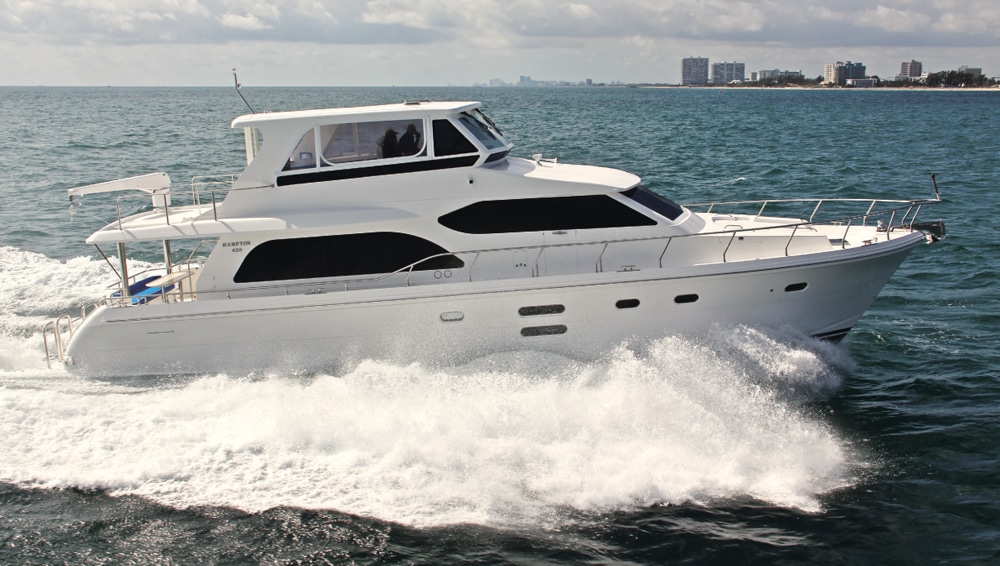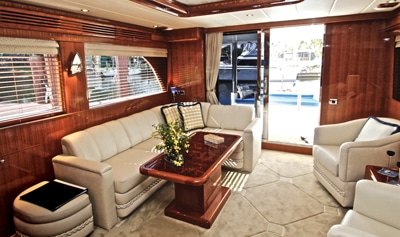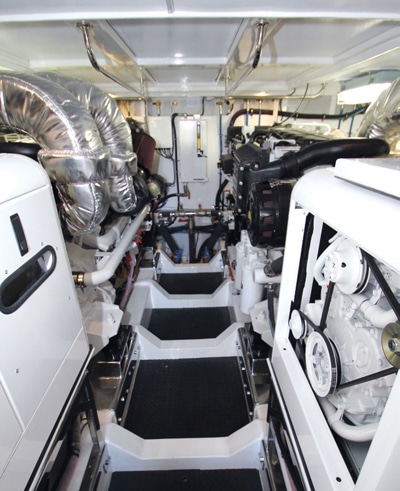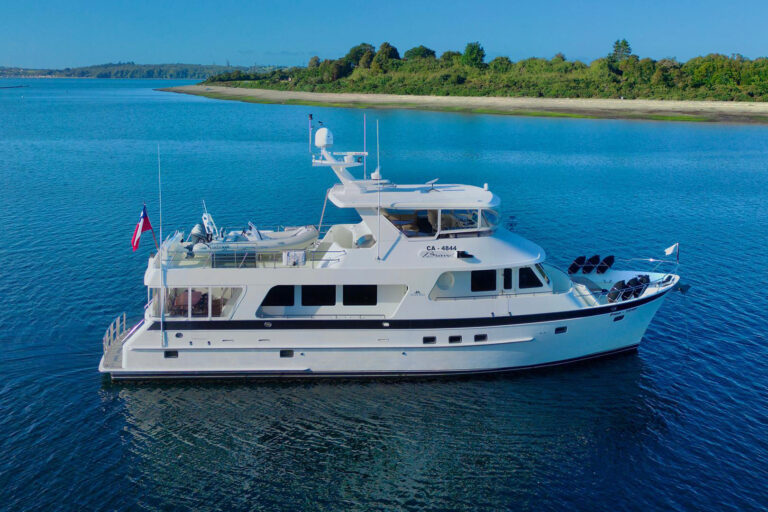
Hampton 620
Every time I review a new Hampton model with Anchor Yacht Sales of Fort Lauderdale, Florida, it serves as a reminder that a yacht can be more than the sum of its designer and builder: It’s sometimes about the dealer too. In many cases, a dealer is little more than a cleaning service between builder and buyer, but, when it comes to Capt. Forest Roberts and Anchor Yachts, you get the full measure of his wisdom and experience.
I can spin the usual review of the new Hampton 620 — tell you where the galley is located, how the staterooms are arranged and the size of the engines. But the real beauty of this yacht is in the details, some of which are from the factory but many that are the result of Roberts and his team.
Take, for example, the air-conditioning system. You’ve spent $2 million on your dream yacht, you’re far from civilization in the islands, and suddenly your air-conditioning pump fails. Now you have no a/c and it is steamy inside and out. On most boats, this would mean a frantic call to the States, expensive air freight to get the pump and then a search for someone to hook it up a few days later.
On the Hampton 62 from Anchor, you climb into the bilge, flip a switch and restart the air conditioning: There is a redundant pump because Roberts doesn’t want you baking in the tropics. The same is true of the compressor: There is a redundant 120,000 Btu unit.
Everywhere I looked on our test Hampton 620, there was this same belt-and-suspenders redundancy: two hydraulic power take-offs that were interlinked, two pumps for the Headhunter system, two separate GPS antennas, two VHF radios, backup hydraulic steering and two Glendinning Cablemaster reels. Impressive and very seamanlike.
The Hampton 620 was developed by stretching the already successful 580, which has cascading benefits. A larger salon and cockpit are obvious, but the additional length also creates a spacious lazarette (or crew quarters), enlarges the master suite and allows for the modified skylounge on the bridge. Plus, the longer running surface adds to her stability without diminishing speed.
Construction is impressive, with a solid fiberglass hull up to the rub rail, foam-cored stringers throughout and no wood other than the interior finish. Anchor Yachts has been Hampton’s Dealer of the Year for six years straight, so when Anchor talks, Hampton listens. For years, Anchor has been having its Hamptons built with triple layers of Kevlar reinforcing the collision zone forward, and this is now standard on all Hamptons: chine-to-chine Kevlar that reaches 18 feet abaft the bow, where you’re most likely to whack something.
The interior on our test 620 has a high-gloss cherry interior with burled inlays, and the airy salon is notable for the 40-inch TV hidden behind a pop-up mirror and the custom leather furniture with built-in stowage.
The country galley is up, facing a granite dining table and settee, with pantograph doors on each side leading to the walkaround decks. Again, details tell the story: The galley drawers (and others throughout) are solid wood with dovetail joints and sturdy rollers. And custom stainless-steel clamps keep the 21-cubic-foot refrigerator and twin freezer drawers closed.
Down a curving stairwell from the galley/dining area is a foyer that hides a full-size washer on one side and a dryer on the other. The larger of the guest staterooms is forward with a raised queen berth and en suite head with Tecma MSD and oversize Corian stall shower. A guest cabin has twin berths and a door to the day-head across the corridor.
The master stateroom spans the full beam, with a queen berth and a pair of large opening ports above a vanity to port. A walk-in locker is aft to port but, wait! This cabin has two more cedar-lined hanging lockers and a shirt locker, plus huge drawers under the berth and more drawers in a bureau to starboard. This is live-aboard stowage. The head is large, with Corian “tiles” on the floor and a tower with multiple jets in the shower.

Ok, I admit it: I loved the bridge or the skylounge or whatever you call it. First, it’s very large and has room enough for a pair of big Pompanette helm chairs (the skipper gets the powered one) behind the fiberglass instrument pod. Our test 620 had a pair of Raymarine 120 displays, digital Caterpillar monitors, a panel for the Wesmar three- term gyro stabilizers and jog sticks for the Side-Power bow and stern thrusters. In front of the companion seat is a huge chart locker for those of us who love our paper charts. Just aft is an L-shape settee opposite a wet bar console with fridge/freezer, sink and 30-inch TV.
Here’s what I really liked: While the bridge has tempered-glass forward windows, the remaining space is surrounded by a Strataglass enclosure that unzips easily when you want a breeze. The rest of the time, this is a climate-controlled skylounge with two 18,000 Btu and one 9,000 Btu (there’s that redundancy again!) a/c units and doors to the boat deck. That deck, by the way, has a 1,000-pound UMT power davit, and there is easily room for a 12- foot tender — and, on our test boat, a pair of electric motorcycles for the owners’ shore excursions.
Power is a pair of 873-horsepower Caterpillar C18s, which is an increase from the standard 715-horsepower Cummins QSM11s, and you can go all the way to 1,015-horsepower Cats if you choose. Our test boat had twin Kohler gensets of 23 kW and 15.5 kW (redundancy!), plus a Charles Industries isoboost transformer and separate Charles 50- and 30-amp chargers for the house and generator batteries. Access is excellent, and the lazarette is large enough to have its own workbench.

Under way, the Hampton 620 was solid and comfortable, even in the very lumpy seas on our test day. Full throttle gave us more than 21 knots, but more important, we loped along at better than 12 knots at 50 percent load while sipping just 15 gallons per hour.
It’s easy to see quality in perfect joints in the woodwork (which the Hampton 620 has in spades), but unseen touches — like backing the AC/DC panels with 400-degree fire-resistant surfaces in case of a short — speak to an even more substantial quality. You may not see all these, but you’ll sleep better knowing they are there.
The real beauty of this yacht is in the details.
LOA: 63’10”
Beam: 17’3″
Draft: 5’1″
Displ.: 90,000 lb.
Fuel: 1,200 gal.
Water: 300 gal.
Test Power: 2 x 873 hp Caterpillar C18 diesels
Standard Power: 2 x 715 hp Cummins QSM11 diesels
Price as Tested: $2,188,800
Hampton Yachts, 888-221-1320; www.hamptonyachts.com
_View a complete gallery of the Hampton 620._
Subscribe to the Yachting Life newsletter for cruising and chartering guides, new boat announcements, event updates, special offers and more!









